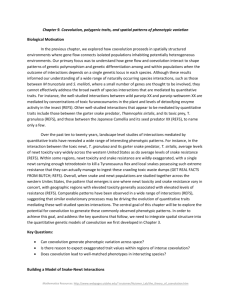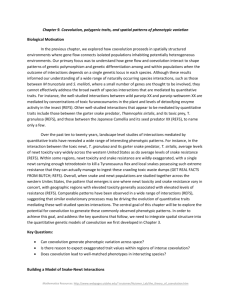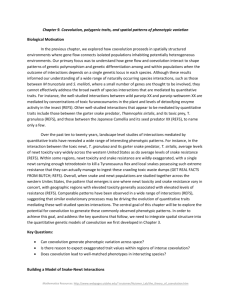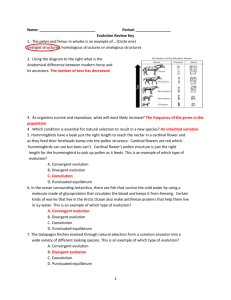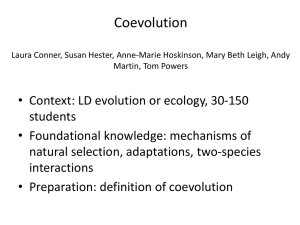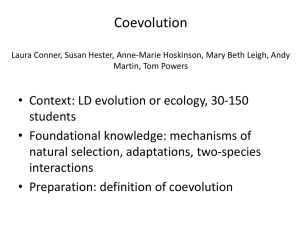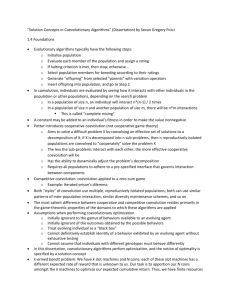Chapter 9. Coevolution, polygenic traits, and spatial patterns of
advertisement
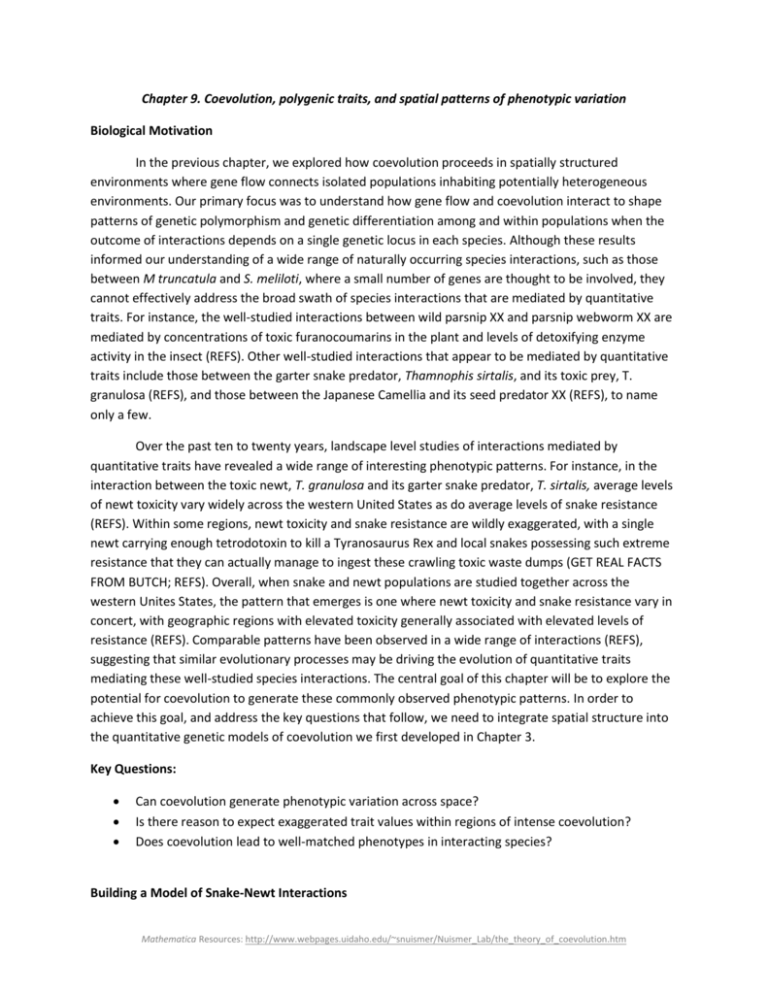
Chapter 9. Coevolution, polygenic traits, and spatial patterns of phenotypic variation Biological Motivation In the previous chapter, we explored how coevolution proceeds in spatially structured environments where gene flow connects isolated populations inhabiting potentially heterogeneous environments. Our primary focus was to understand how gene flow and coevolution interact to shape patterns of genetic polymorphism and genetic differentiation among and within populations when the outcome of interactions depends on a single genetic locus in each species. Although these results informed our understanding of a wide range of naturally occurring species interactions, such as those between M truncatula and S. meliloti, where a small number of genes are thought to be involved, they cannot effectively address the broad swath of species interactions that are mediated by quantitative traits. For instance, the well-studied interactions between wild parsnip XX and parsnip webworm XX are mediated by concentrations of toxic furanocoumarins in the plant and levels of detoxifying enzyme activity in the insect (REFS). Other well-studied interactions that appear to be mediated by quantitative traits include those between the garter snake predator, Thamnophis sirtalis, and its toxic prey, T. granulosa (REFS), and those between the Japanese Camellia and its seed predator XX (REFS), to name only a few. Over the past ten to twenty years, landscape level studies of interactions mediated by quantitative traits have revealed a wide range of interesting phenotypic patterns. For instance, in the interaction between the toxic newt, T. granulosa and its garter snake predator, T. sirtalis, average levels of newt toxicity vary widely across the western United States as do average levels of snake resistance (REFS). Within some regions, newt toxicity and snake resistance are wildly exaggerated, with a single newt carrying enough tetrodotoxin to kill a Tyranosaurus Rex and local snakes possessing such extreme resistance that they can actually manage to ingest these crawling toxic waste dumps (GET REAL FACTS FROM BUTCH; REFS). Overall, when snake and newt populations are studied together across the western Unites States, the pattern that emerges is one where newt toxicity and snake resistance vary in concert, with geographic regions with elevated toxicity generally associated with elevated levels of resistance (REFS). Comparable patterns have been observed in a wide range of interactions (REFS), suggesting that similar evolutionary processes may be driving the evolution of quantitative traits mediating these well-studied species interactions. The central goal of this chapter will be to explore the potential for coevolution to generate these commonly observed phenotypic patterns. In order to achieve this goal, and address the key questions that follow, we need to integrate spatial structure into the quantitative genetic models of coevolution we first developed in Chapter 3. Key Questions: Can coevolution generate phenotypic variation across space? Is there reason to expect exaggerated trait values within regions of intense coevolution? Does coevolution lead to well-matched phenotypes in interacting species? Building a Model of Snake-Newt Interactions Mathematica Resources: http://www.webpages.uidaho.edu/~snuismer/Nuismer_Lab/the_theory_of_coevolution.htm In Chapter 3, we developed a model of coevolution between two species mediated by quantitative traits and a mechanism of phenotype differences. This model assumes the probability of a “successful” interaction occurring depends on the extent to which the phenotype of one species exceeds that of the other (Chapter 3, Figure X). In the context of interactions between T. sirtalis and T. granulosa, a “successful” interaction is one where the snake successfully consumes the newt, with the probability of consumption depending on the quantity of tetrodotoxin in the newt (𝑦̅) and the resistance to tetrodotoxin in the snake (𝑥̅ ). Of course, we are probably safe to assume that being consumed reduces newt fitness (by an amount 𝑠𝑌 ) and increases snake fitness (by an amount 𝑠𝑋 ). In addition to selection imposed by the interaction, we integrated stabilizing selection toward optimal trait values 𝜃𝑋 and 𝜃𝑌 . These assumptions, along with the classical quantitative genetic assumptions of weak selection, fixed additive genetic variances (𝐺𝑋 and 𝐺𝑌 ), and Gaussian phenotype distributions allowed us to derive expressions for the population mean phenotypes of the interacting species in the next generation: 𝑥̅ ′ ≈ 𝑥̅ + 𝑆𝑋 𝐺𝑋 + 2𝛾𝑋 𝐺𝑋 (𝜃𝑋 − 𝑥̅ ) (1a) 𝑦̅ ′ ≈ 𝑦̅ + 𝑆𝑌 𝐺𝑌 + 2𝛾𝑌 𝐺𝑌 (𝜃𝑌 − 𝑦̅) (1b) where the compound parameters 𝑆𝑋 = 𝛼𝑠𝑋 ⁄(2(2 + 𝑠𝑋 )) and 𝑆𝑌 = 𝛼𝑠𝑌 ⁄(2(2 − 𝑠𝑌 )) measure the strength of coevolutionary selection in each species, the parameters 𝛾𝑋 and 𝛾𝑌 quantify the intensity of stabilizing selection, and the parameter 𝛼 defines the sensitivity of the interaction outcome to the phenotypes of interacting individuals. In order to use this model to study the potential for coevolution to generate spatial patterns like those observed in the interaction between T. sirtalis and T. granulosa, we will need to extend our simple model of coevolution within a single population (1). Although there is a very large number of ways this could be done, we will focus on a simple scenario where populations of snake and newt occupy two geographic locations coupled by recurrent gene flow. The first step in modeling this scenario, is to add another geographic location such that the system of two equations (1) is now replaced by a system of four equations: SELECTION MOSAIC IN HERE. DESCRIBE IT AND STATE WHAT IT MEANS! 𝑥̅𝑖′ = 𝑥̅𝑖 + 𝑆𝑋,𝑖 𝐺𝑋 + 2𝛾𝑋 𝐺𝑋 (𝜃𝑋 − 𝑥̅𝑖 ) (2a) 𝑦̅𝑖′ = 𝑦̅𝑖 + 𝑆𝑌,𝑖 𝐺𝑌 + 2𝛾𝑌 𝐺𝑌 (𝜃𝑌 − 𝑦̅𝑖 ). (2b) where the subscript i indicates geographic location. Next, we need to add the potential for gene flow between populations. Mathematically, we can do this in exactly the same way we did in the previous chapter, by assuming that after selection, a proportion of each population, m, moves to the other population while a proportion (1-m) do not move and remain in their natal population: 𝑥̅𝑖′′ = (1 − 𝑚𝑋 )𝑥̅𝑖′ + 𝑚𝑋 𝑥̅𝑗′ (3a) 𝑦̅𝑖′′ = (1 − 𝑚𝑌 )𝑦̅𝑖′ + 𝑚𝑌 𝑦̅𝑗′ (3b) where the double prime notation indicates the population mean phenotype after both selection and gene flow have occurred. Although this approach is simple and effective, we do need to exercise some 2 mathematical caution when using it. Specifically, it is important to remember that our expressions for the change in mean phenotypes caused by selection (1) assume that phenotype distributions are Gaussian and have constant additive genetic variance, G. Adding the potential for gene flow between populations creates the very real potential that these assumptions could be violated, particularly if the mean phenotypes in the two population exchanging migrants are quite divergent. In such a case, phenotype distributions after gene flow could easily become bimodal, a clear violation of our key assumptions. The best way to make sure our model stays true to its assumptions is to make sure we study only scenarios where mean phenotypes do not become too divergent across populations. Keeping this important caveat in mind, we can now take a crack at analyzing our model (3) and see what we can learn from it about the role coevolution plays in driving spatial patterns of phenotypic diversification. Analyzing the Model Although it is quite possible to analyze the model defined by (3) “as is”, analyses are easier and more insightful if we first make a change of variables much like that we used in the previous chapter. Specifically, we will shift our focus away from individual population mean phenotypes, 𝑥̅𝑖 and 𝑦̅𝑖 , and toward global average phenotypes, 𝜇𝑋 and 𝜇𝑌 , and spatial differences in phenotypes, 𝛿𝑋 and 𝛿𝑌 . In addition to simplifying the mathematics, this change of variables more clearly focuses our attention on the spatial variation in population mean phenotypes. Specifically, we will define the following new variables: 𝜇𝑋 = 𝑥̅1 +𝑥̅2 2 (4a) 𝛿𝑋 = 𝑥̅1 − 𝑥̅2 𝜇𝑌 = (4b) 𝑦̅1 +𝑦̅2 2 (4c) 𝛿𝑌 = 𝑦̅1 − 𝑦̅2 (4d) and use them to re-write the recursion equations (3) as a system of difference equations in terms of the new variables: ∆𝜇𝑋 = 𝐺𝑋 (𝑆𝑋̅ − 2𝛾𝑋 (𝜇𝑋 − 𝜃𝑋 )) (5a) ∆𝛿𝑋 = 𝐺𝑋 (1 − 2𝑚𝑋 )(𝛿𝑆𝑋 − 2𝛾𝑋 𝛿𝑋 ) − 2𝑚𝑋 𝛿𝑋 (5b) ∆𝜇𝑌 = 𝐺𝑌 (𝑆𝑌̅ − 2𝛾(𝜇𝑌 − 𝜃𝑌 )) (5c) ∆𝛿𝑌 = 𝐺𝑌 (1 − 2𝑚𝑌 )(𝛿𝑆𝑌 − 2𝛾𝑌 𝛿𝑌 ) − 2𝑚𝑌 𝛿𝑌 (5d) where 𝑆𝑋̅ = (𝑆𝑋,1 + 𝑆𝑋,2 )/2 and 𝑆𝑌̅ = (𝑆𝑌,𝑖 + 𝑆𝑌,𝑖 )/2 measure the average strength of coevolutionary selection acting on the snake and newt, respectively, and 𝛿𝑆𝑋 = (𝑆𝑋,1 − 𝑆𝑋,2 ) and 𝛿𝑆𝑌 = (𝑆𝑌,1 − 𝑆𝑌,2 ) measure the difference in the intensity of coevolutionary selection acting on snake and newt, respectively. Interestingly, (3) shows that the coevolutionary dynamics of average phenotypes are 3 decoupled from the coevolutionary dynamics of spatial structure. We can capitalize on this independence to first solve for the coevolutionary dynamics oif trait means, which is identical to what we did in Chapter 3 and has time depdnent solution: Next, we can study how spatial structure coevolves using (4b,d). Thus, ultimately, we expect coevolution between snake and newt to lead to an equilibrium where: 𝑆̅ 𝜇̂ 𝑋 = 𝜃𝑋 + 2𝛾𝑋 (5a) 𝑋 (1−2𝑚𝑋 ) 𝛿𝑆 𝐺𝑋 𝛿̂𝑋 = 2𝛾 𝐺 𝑋(1−2𝑚 (5b) 𝑋 )+2𝑚𝑋 𝑋 𝑋 𝑆̅ 𝜇̂ 𝑌 = 𝜃𝑌 + 2𝛾𝑌 (5c) 𝑌 (1−2𝑚𝑌 ) 𝛿𝑆 𝐺𝑌 𝛿̂𝑌 = 2𝛾 𝐺 𝑌(1−2𝑚 𝑌 𝑌 (5d) 𝑌 )+2𝑚𝑌 So what can we learn from (5)? First, we see that as long as selection mosaics are present in both species, we will observe spatial variability in the population mean phenotypes of the interacting species. In the case of interactions between the snake and newt we would observe spatial variability on newt tetrodotoxin concentrations and snake resistance directly proportional to the strength of the selection mosaics acting on each species. What this implies is that the larger the difference in the fitness consequences of interactions across sites, the greater the difference in population mean trait values (Figure 1). Second, our equilibrium solution clearly shows that the populations with the strongest fitness consequences of interactions (coevolutionary hot spots) will be those where the traits mediating the interaction are most exaggerated (Figure 1). Finally, we can use (5) to identify the conditions under which the traits of the interacting species will match, or be positively correlated across space. The easiest way to do this is to recognize that the population mean trait values of the two species will be positively correlated anytime the product 𝛿̂𝑋 × 𝛿̂𝑌 is greater than zero. Inspecting this product shows that this can only occur if the product of the selection mosaics, 𝛿𝑆𝑋 × 𝛿𝑆𝑌 , is also greater than zero (Figure 1). Taken together, our results suggest that c Answers to Key Questions: Can coevolution generate phenotypic variation across space? Potentially. Our results show that in a homogenous environment, coevolution alone cannot cause population mean phenotypes to diverge among populations. However, when species interactions impose different fitness consequences in different geographic regions, population mean phenotypes 4 escalate to different degrees. The result of this differential escalation is spatial variation in mean phenotype. Is there reason to expect exaggerated trait values within regions of intense coevolution? Yes. Regions where both species experience strong fitness consequences from interacting, and thus intense coevolution, should be characterized by exaggerated trait values. The extent to which trait values are exaggerated in these coevolutionary “hot spots” depends on the balance between coevolutionary selection and stabilizing selection. Does coevolution lead to well-matched phenotypes in interacting species? Potentially. If both species experience stronger than average selection from species interactions in the same geographic locations and weaker than average selection from species interactions in the same geographic locations, the population mean phenotypes of the two species will be positively correlated and well-matched. Put differently, if the fitness consequences of species interactions are positively correlated, then so too will population mean phenotypes. If, however, the fitness consequences of interactions are uncorrelated or negatively correlated, the population mean phenotypes of the interacting species will also be uncorrelated or even systemically mismatched. New Questions Arising: Our simple model of coevolution between the snake XX and the newt XX has provided us with several interesting insights into the potential for coevolution to generate spatial variation in the quantitative traits mediating the interaction. In addition, our model has also identified conditions under which coevolution is likely to cause the phenotypes of the species to be correlated over space. At the same time, however, our model has ignored other forces that may also generate spatially variable and correlated phenotypes and has focused on only a single class of ecological interaction mediated by a particular functional relationship between quantitative traits. These limitations of our basic model lead to several obvious questions: Can forces other than coevolution produce spatially variable and potentially correlated phenotypes? Are some functional forms of interaction more likely to produce spatial variation and correlation than others? Should we expect mutualistic interactions to produce similar patterns of spatial phenotypic variation and trait correlation? In the next three sections, we will develop extensions and variations of our basic model that allow us to answer these questions and gain further insight into the process of coevolution. Extensions 5 Extension 1: Can forces other than coevolution produce spatially variable and potentially correlated phenotypes? 𝑥̅𝑖′ ≈ 𝑥̅𝑖 + 𝑆𝑋 𝐺𝑋 + 2𝛾𝑋 𝐺𝑋 (𝜃𝑋,𝑖 − 𝑥̅𝑖 ) (6a) 𝑦̅𝑖′ ≈ 𝑦̅𝑖 + 𝑆𝑌 𝐺𝑌 + 2𝛾𝑌 𝐺𝑌 (𝜃𝑌,𝑖 − 𝑦̅𝑖 ) (6b) WARNING: EXPLAIN DANGERS OF DISTANT THETAS AND APPROXIMATIONS… 𝑥̅𝑖′′ ≈ (1 − 𝑚𝑋 )𝑥̅𝑖′ + 𝑚𝑋 𝑥̅𝑗′ (7a) 𝑦̅𝑖′′ ≈ (1 − 𝑚𝑌 )𝑦̅𝑖′ + 𝑚𝑌 𝑦̅𝑗′ (7b) ∆𝜇𝑋 = 𝐺𝑋 (𝑆𝑋 − 2𝛾𝑋 (𝜇𝑋 − 𝜃𝑋̅ )) (8a) ∆𝛿𝑋 = −2𝑚𝑋 𝛿𝑋 − 2𝛾𝑋 𝐺𝑋 (1 − 2𝑚𝑋 )(𝛿𝑋 − 𝛿𝜃𝑋 ) (8b) ∆𝜇𝑌 = 𝐺𝑌 (𝑆𝑌 − 2𝛾(𝜇𝑌 − 𝜃̅𝑌 )) (8c) ∆𝛿𝑌 = −2𝑚𝑌 𝛿𝑌 + 2𝛾𝑌 𝐺𝑌 (1 − 2𝑚𝑌 )(𝛿𝑌 − 𝛿𝜃𝑌 ) (8d) 𝑆 𝜇̂ 𝑋 = 𝜃𝑋̅ + 2𝛾𝑋 (9a) 𝑋 (1−2𝑚𝑋 ) 𝛾𝑋 𝐺𝑋 𝛿𝜃𝑋 𝛿̂𝑋 = 𝛾 𝐺 (1−2𝑚 𝑋 𝑋 (9b) 𝑋 )+𝑚𝑋 𝑆 𝜇̂ 𝑌 = 𝜃̅𝑌 + 2𝛾𝑌 (9c) 𝑌 (1−2𝑚𝑌 ) 𝛾𝑌 𝐺𝑌 𝛿𝜃𝑌 𝛿̂𝑌 = 𝛾 𝐺 (1−2𝑚 𝑌 𝑌 (9d) 𝑌 )+𝑚𝑌 We are now in a good place to use equations (8) to learn more about the potential origins of spatial variation in the traits mediating interactions between species. First, we see that as long as the optimum phenotypes favored by stabilizing selection vary across space so too will the population mean phenotypes of the interacting species. This is true even if coevolutionary selection is entirely absent (e.g., S->0). Second, our equilibrium solution clearly shows that populations where both snake and newt 6 are less constrained will be those where the traits mediating the interaction are most exaggerated (Figure 3). Third, equations (5) allow us to identify conditions under which the traits of the interacting species will match, or be positively correlated across space. The easiest way to do this is to recognize that the population mean trait values of the two species will be positively correlated anytime the product 𝛿̂𝑋 × 𝛿̂𝑌 is greater than zero. Inspecting this product shows that this can only occur if the product of the selection mosaics, 𝛿𝜃𝑋 × 𝛿𝜃𝑌 , is also greater than zero (Figure 2). So how do these mathematical results better inform our understanding of the potential causes shaping the remarkable patterns we observe in the snake new interaction? result mean for Returning again to the interactions between snake and newt, this result implies that we will observe spatial variation in toxicity and resistance anytime could, in principle be fooled into believing we had a coevolutionary hot spot if there exist regions where, for whatever reason, stabilizing selection favors larger trait values independent of coevolution. This might occur, if, for instance, the cost of producing tetrodotoxin were less within a population that also imposed reduced costs of modifying your sodium channels… Extension 2: Are some functional forms of interaction more likely to produce spatial variation and correlation than others? 𝑥̅𝑖′ ≈ 𝑥̅𝑖 + 𝑆𝑋 𝐺𝑋 (𝑦̅𝑖 − 𝑥̅𝑖 ) + 2𝛾𝑋 𝐺𝑋 (𝜃𝑋,𝑖 − 𝑥̅𝑖 ) (10a) 𝑦̅𝑖′ ≈ 𝑦̅𝑖 + 𝑆𝑌 𝐺𝑌 (𝑦̅𝑖 − 𝑥̅𝑖 ) + 2𝛾𝑌 𝐺𝑌 (𝜃𝑌,𝑖 − 𝑦̅𝑖 ) (10b) where 𝑆𝑋 = 2𝛼𝑠𝑋 ⁄(1 + 𝑠𝑋 ) and 𝑆𝑌 = 2𝛼𝑠𝑌 ⁄(1 − 𝑠𝑌 ) 𝑥̅𝑖′′ ≈ (1 − 𝑚𝑋 )𝑥̅𝑖′ + 𝑚𝑋 𝑥̅𝑗′ (10a) 𝑦̅𝑖′′ ≈ (1 − 𝑚𝑌 )𝑦̅𝑖′ + 𝑚𝑌 𝑦̅𝑗′ (10b) NOW WE MAKE A CHANGE OF VARIABLES AND ALSO ASSUME m is small ∆𝜇𝑋 = 𝑆𝑋 𝐺𝑋 (𝜇𝑌 − 𝜇𝑋 ) − 2𝛾𝑋 𝐺𝑋 (𝜇𝑋 − 𝜃𝑋̅ ) (11a) ∆𝛿𝑋 = −2𝑚𝑋 𝛿𝑋 − 𝐺𝑋 (𝑆𝑋 (𝛿𝑋 − 𝛿𝑌 ) + 2𝛾𝑋 (𝛿𝑋 − 𝛿𝜃𝑋 )) (11b) ∆𝜇𝑌 = 𝑆𝑌 𝐺𝑌 (𝜇𝑌 − 𝜇𝑋 ) − 2𝛾𝑌 𝐺𝑌 (𝜇𝑌 − 𝜃̅𝑌 ) (11c) 7 ∆𝛿𝑌 = −2𝑚𝑌 𝛿𝑌 − 𝐺𝑌 (𝑆𝑌 (𝛿𝑋 − 𝛿𝑌 ) + 2𝛾𝑌 (𝛿𝑌 − 𝛿𝜃𝑌 )) _ 𝜇̂ 𝑋 = _ 𝛾𝑋 (𝑆𝑌 −2𝛾𝑌 )𝜃𝑋 −𝑆𝑋 𝛾𝑌 𝜃𝑌 𝑆𝑌 𝛾𝑋 −(𝑆𝑋 +2𝛾𝑋 )𝛾𝑌 𝛿̂𝑋 = 𝐺 (12a) 2𝐺𝑋 (𝛾𝑋 (2𝑚𝑌 −𝐺𝑌 (𝑆𝑌 −2𝛾𝑌 ))𝛿𝜃𝑋 +𝐺𝑌 𝑆𝑋 𝛾𝑌 𝛿𝜃𝑌 ) 𝑋 𝐺𝑌 𝑆𝑋 𝑆𝑌 +(2𝑚𝑋 +𝐺𝑋 (𝑆𝑋 +2𝛾𝑋 ))(2𝑚𝑌 −𝐺𝑌 (𝑆𝑌 −2𝛾𝑌 )) _ 𝜇̂ 𝑌 = (12b) _ −𝑆𝑌 𝛾𝑋 𝜃𝑋 +(𝑆𝑋 +2𝛾𝑋 )𝛾𝑌 𝜃𝑌 −𝑆𝑌 𝛾𝑋 +(𝑆𝑋 +2𝛾𝑋 )𝛾𝑌 𝛿̂𝑌 = 𝑚 (11d) (12c) 𝐺𝑌 (𝐺𝑋 𝑆𝑌 𝛾𝑋 𝛿𝜃𝑋 −(2𝑚𝑋 +𝐺𝑋 (𝑆𝑋 +2𝛾𝑋 ))𝛾𝑌 𝛿𝜃𝑌 ) 𝑋 (−2𝑚𝑌 +𝐺𝑌 (𝑆𝑌 −2𝛾𝑌 ))−𝐺𝑋 (𝑚𝑌 (𝑆𝑋 +2𝛾𝑋 )+𝐺𝑌 (−𝑆𝑌 𝛾𝑋 +(𝑆𝑋 +2𝛾𝑋 )𝛾𝑌 )) What about stability? 𝐽𝜇 = [ 1 − 𝐺𝑋 (𝑆𝑋 + 2𝛾𝑋 ) 𝐺𝑋 𝑆𝑋 ] −𝐺𝑌 𝑆𝑌 1 + 𝐺𝑌 (𝑆𝑌 − 2𝛾𝑌 ) 1 − 2𝑚𝑋 − 𝐺𝑋 (𝑆𝑋 + 2𝛾𝑋 ) 𝐺𝑋 𝑆𝑋 𝐽𝛿 = [ ] −𝐺𝑌 𝑆𝑌 1 − 2𝑚𝑌 + 𝐺𝑌 (𝑆𝑌 − 2𝛾𝑌 ) 8 (12d) Extension 3: Should we expect mutualistic interactions to produce similar patterns of spatial phenotypic variation and trait correlation? 𝑥̅𝑖′ ≈ 𝑥̅𝑖 + 𝑆𝑋 𝐺𝑋 (𝑦̅𝑖 − 𝑥̅𝑖 ) + 2𝛾𝑋 𝐺𝑋 (𝜃𝑋,𝑖 − 𝑥̅𝑖 ) (10a) 𝑦̅𝑖′ ≈ 𝑦̅𝑖 + 𝑆𝑌 𝐺𝑌 (𝑥̅𝑖 − 𝑦̅𝑖 ) + 2𝛾𝑌 𝐺𝑌 (𝜃𝑌,𝑖 − 𝑦̅𝑖 ) (10b) where 𝑆𝑋 = 2𝛼𝑠𝑋 ⁄(1 + 𝑠𝑋 ) and 𝑆𝑌 = 2𝛼𝑠𝑌 ⁄(1 + 𝑠𝑌 ) 𝑥̅𝑖′′ ≈ (1 − 𝑚𝑋 )𝑥̅𝑖′ + 𝑚𝑋 𝑥̅𝑗′ (10a) 𝑦̅𝑖′′ ≈ (1 − 𝑚𝑌 )𝑦̅𝑖′ + 𝑚𝑌 𝑦̅𝑗′ (10b) NOW WE MAKE A CHANGE OF VARIABLES AND ALSO ASSUME m is small ∆𝜇𝑋 = 𝑆𝑋 𝐺𝑋 (𝜇𝑌 − 𝜇𝑋 ) − 2𝛾𝑋 𝐺𝑋 (𝜇𝑋 − 𝜃𝑋̅ ) (11a) ∆𝛿𝑋 = −2𝑚𝑋 𝛿𝑋 − 𝐺𝑋 (𝑆𝑋 (𝛿𝑋 − 𝛿𝑌 ) + 2𝛾𝑋 (𝛿𝑋 − 𝛿𝜃𝑋 )) (11b) ∆𝜇𝑌 = 𝑆𝑌 𝐺𝑌 (𝜇𝑋 − 𝜇𝑌 ) − 2𝛾𝑌 𝐺𝑌 (𝜇𝑌 − 𝜃̅𝑌 ) (11c) ∆𝛿𝑌 = −2𝑚𝑌 𝛿𝑌 − 𝐺𝑌 (𝑆𝑌 (𝛿𝑌 − 𝛿𝑋 ) + 2𝛾𝑌 (𝛿𝑌 − 𝛿𝜃𝑌 )) (11d) 𝜇̂ 𝑋 = 𝛿̂𝑋 = 𝜇̂ 𝑌 = ̅𝑌 +𝛾𝑋 (𝑆𝑌 +2𝛾𝑌 )𝜃 ̅𝑋 𝑆𝑋 𝛾𝑌 𝜃 𝑆𝑌 𝛾𝑋 +(𝑆𝑋 +2𝛾𝑋 )𝛾𝑌 (12a) 𝐺𝑋 (𝛾𝑋 (2𝑚𝑌 +𝐺𝑌 (𝑆𝑌 +2𝛾𝑌 ))𝛿𝜃𝑋 +𝐺𝑌 𝑆𝑋 𝛾𝑌 𝛿𝜃𝑌 ) 𝑚𝑋 (2𝑚𝑌 +𝐺𝑌 (𝑆𝑌 +2𝛾𝑌 ))+𝐺𝑋 (𝑚𝑌 (𝑆𝑋 +2𝛾𝑋 )+𝐺𝑌 (𝑆𝑌 𝛾𝑋 +(𝑆𝑋 +2𝛾𝑋 )𝛾𝑌 )) ̅𝑋 +(𝑆𝑋 +2𝛾𝑋 )𝛾𝑌 𝜃 ̅𝑌 𝑆𝑌 𝛾𝑋 𝜃 𝑆𝑌 𝛾𝑋 +(𝑆𝑋 +2𝛾𝑋 )𝛾𝑌 𝛿̂𝑌 = 𝑚 (12b) (12c) 𝐺𝑌 (𝐺𝑋 𝑆𝑌 𝛾𝑋 𝛿𝜃𝑋 +(2𝑚𝑋 +𝐺𝑋 (𝑆𝑋 +2𝛾𝑋 ))𝛾𝑌 𝛿𝜃𝑌 ) 𝑋 (2𝑚𝑌 +𝐺𝑌 (𝑆𝑌 +2𝛾𝑌 ))+𝐺𝑋 (𝑚𝑌 (𝑆𝑋 +2𝛾𝑋 )+𝐺𝑌 (𝑆𝑌 𝛾𝑋 +(𝑆𝑋 +2𝛾𝑋 )𝛾𝑌 )) Conclusions and Synthesis 9 (12d) 10 Tables Figure Legends References 11
